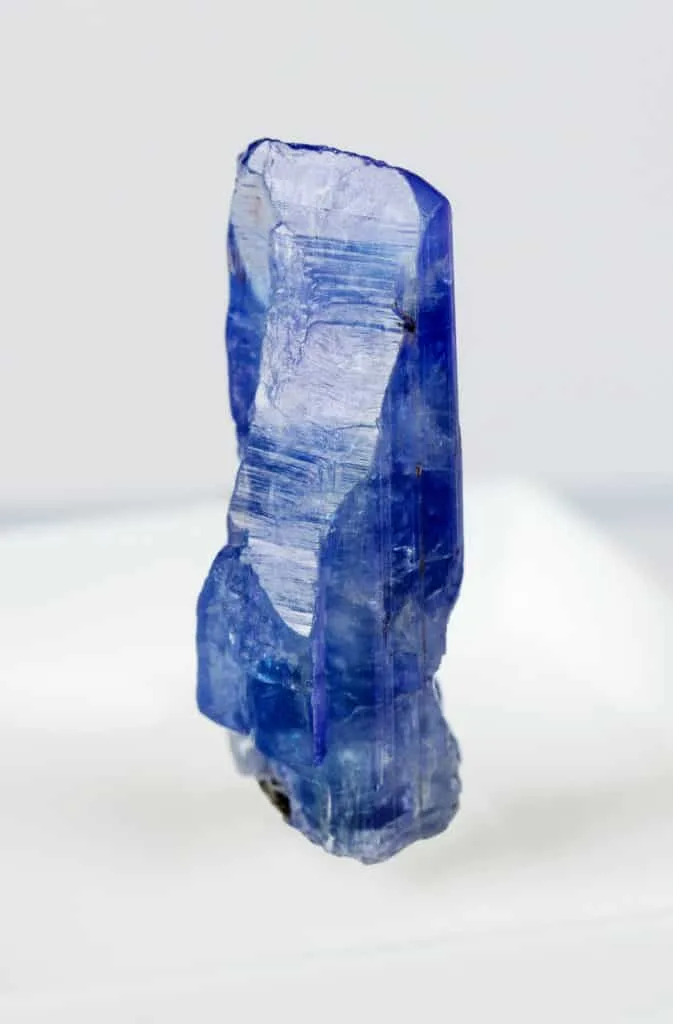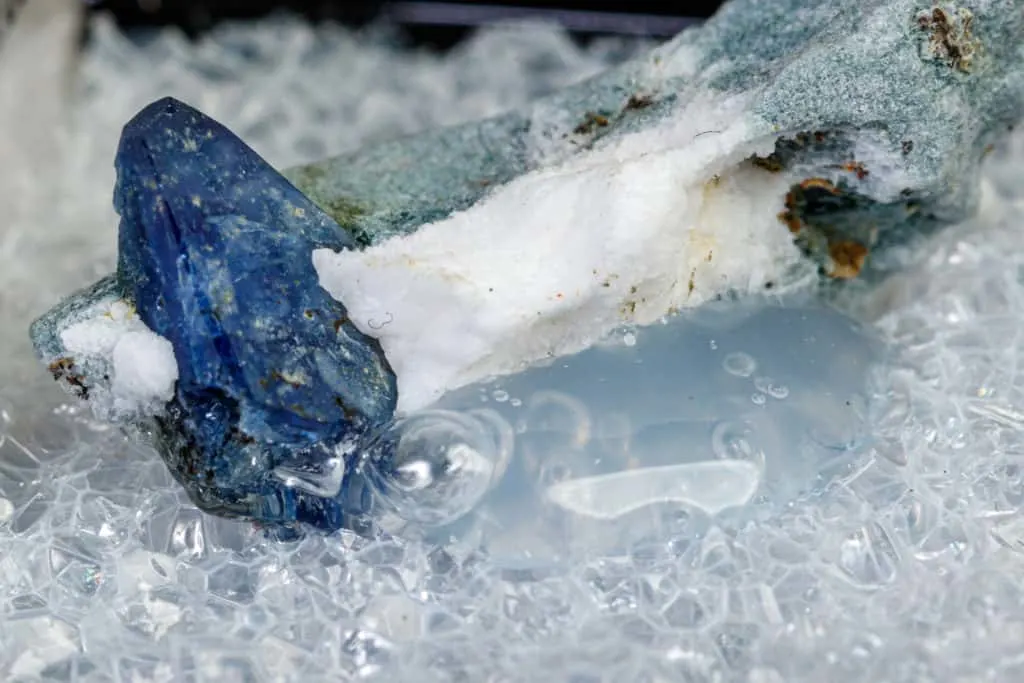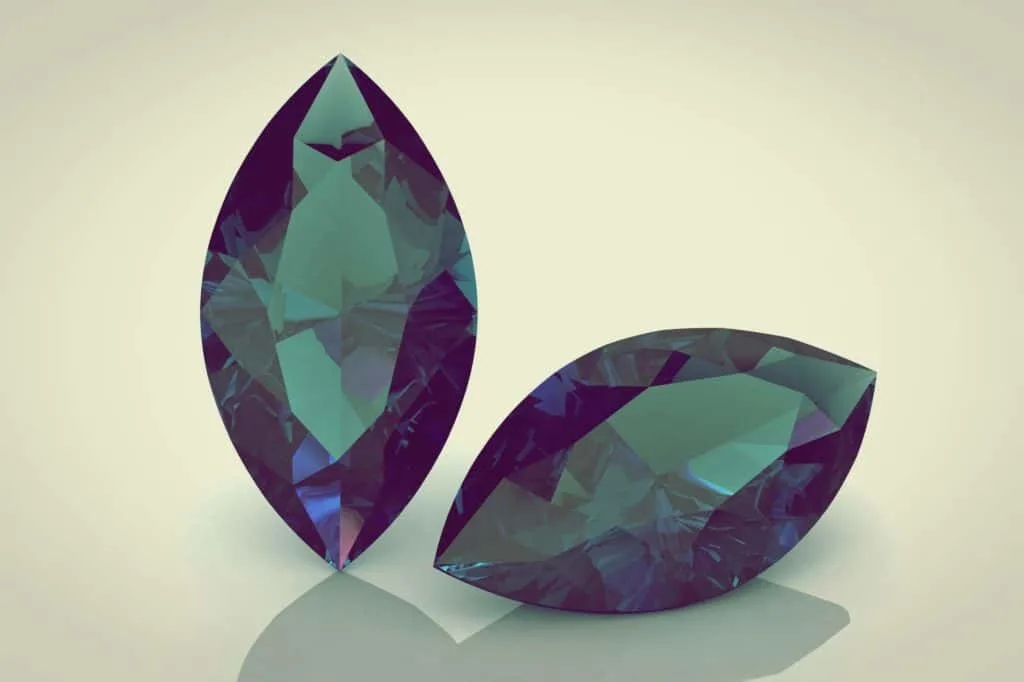As an Amazon Associate, I earn from qualifying purchases with no additional costs for you.
When we hear a rare gemstone collocation, we immediately imagine a sparkling diamond on a velvet pillow. But it’s just a huge misconception, triggered by aggressive advertising. There are a lot of gems that are far rarer and more expensive than diamonds. We are proud to describe them to our readers.
Rare gemstones are minerals that are usually found in one or two locations in the world. They are: poudretteite, paraiba tourmaline, taaffeite, tanzanite, laurentthomasite, red beryl (bixbite), benitoite, alexandrite, musgravite, painite, grandidierite, jeremejevite, pezzottaite.
So diamonds aren’t rare? What is a rarity? Is that the number of mines, which supply gemstones? Is that amount of stones extracted during a year? Ten years? The whole of human history? Does beauty influence the term rarity somehow? And is a gemstone a synonym for a mineral? The answers to these questions are necessary for understanding why only the next 13 minerals are represented here. Keep going for the scientifically grounded and exclusive material!

If you are interested in checking out the best books about rocks and minerals identification you can find them by clicking here (Amazon link).
What is Rarity in Gemstone‘s World?
A gemstone is generally defined as any mineral that is highly valued for its three main characteristics: beauty, durability, and rarity, and has been enhanced somehow.
In terms of mineral ecology, a rare mineral is a mineral found in less than five localities. An endemic mineral is that one found in the only locality in the world. At the same time, the widespread mineral can be considered so if it is reported from more than 650 localities.
Much more than that ─ over half of all known minerals are considered rare, meaning they appear in five or fewer locations on Earth. However, a mineral and a gemstone are not synonyms. To be a gemstone, a mineral should be also beautiful and durable!
Do you consider a diamond a rare mineral? Everybody used to think that prices are so high because of their deficiency. The diamond shortage gives rise to passionate desire and people cannot imagine an engagement, wedding, or anniversary without this tiny sparkle stone.
However, diamonds are found in> 650 localities! And getting back to formal classification (where the mineral is thought to be widespread if it is found in more than 650 localities) diamond belongs to the same group as quartz!
What Are the Rarest Gemstones on Earth?
So you already know what rarity in the gemstone’s world means. So now let’s dive into the description of the most interesting information about the rarest gemstones in the world!
Poudretteite
Poudretteite appeared in a gem-quality version only in 2000. The gemstone arose like a phoenix and shook gemologists from all over the world.
Poudretteite is a rare gemstone discovered at Mont Saint-Hilaire, Quebec, Canada, during the mid-1960s. Until 2000, these were the only specimens of poudretteite known to exist with no gemstone potential. In 2000, 3 ct faceted gemstone was purchased in Mogok and later changed the status of the mineral.
Now poudretteite, ideally KNa₂B₃Si₁₂O₃₀, switched its status from an endemic mineral to a very rare gemstone which is highly desirable among desperate mineral collectors.
Tanzanite

Tanzanite is believed to be an extremely rare mineral. However, even being mined just from one locality, it is commonly found on mineral shows all over the world.
Tanzanite is a relatively recent discovery. Tiffany & Co named this blue-violet variety of zoisite in honor of Tanzania, where it was first unearthed in 1967. Because the crystals show different colors depending on the viewing direction, they can be fashioned in a range of colors from violet to electric blue.
Experts predict the rising price of tanzanite because of the mine depletion in the next 10-20 years.
According to a Large Number of Rare Events statistical theories, more tanzanite occurrence localities are likely to be discovered in the future.
Especially in combination with constantly evolving geological surveying methods and mineralogical research equipment.
Also, we should not forget that tanzanite Ca2Al3(SiO4)3(OH) is just a trading name for V-bearing zoisite. Zoisite deposits are spread all over the world (Austria, Germany, the USA (Tennessee), and Russia).
The same geological conditions needed for tanzanite formation were reported from Kenya, Madagascar, Pakistan, and even East Antarctica. So most probably we can expect tanzanite discoveries from the areas listed above.
TIP: Getting to the rarest gemstones is not easy. But what about making your own gemstone at home? It is quite easy making a sea glass at home. Check out a step-by-step guide on how to do it in the article below:
Step-by-Step: Making Sea Glass With & Without Rock Tumbler
Paraíba Tourmaline
Paraíba tourmaline is another unique gemstone. It quickly caught the attention of gem lovers because of its neon-blue to green exclusive color.
Paraíba tourmaline, a copper-bearing variety of tourmaline, was discovered in the state of Paraíba in Brazil in 1989. Due to its intense color, this gemstone became one of the most desirable stones in a flash. A few years later, similarly colored gemstones were discovered in Nigeria and Mozambique.
Today Paraíba tourmaline, together with tanzanite, is the crown of any mineral and gems collection. One-of-a-kind color makes it highly desirable among colored stones.
Taaffeite
What do you imagine when you hear about the discovery of a brand-new and previously unknown gemstone? Some of your thoughts might go to the gravel of a stream or river flowing in a distant mountain range or some exotic jungles.
However, nowadays a discovery of a new mineral mostly takes place in a laboratory. Scientists are scanning a sample using an electron microscope and can run into a tiny mineral with an extremely complex formula.
But no one can imagine a new gemstone discovery inside the stone that had already been faceted!
Taaffeite is the only gemstone in history to have been identified inside a stone that had already been faceted! Taaffeite is beryllium, magnesium, and aluminum oxide of unforgettable and rare lavender color. Due to double refraction and high hardness, taaffeite is suitable for jewelry.
The unbelievable discovery of taaffeite (Mg3Al8BeO16) happened relatively recently in 1945. Richard Taaffe, a gemologist, found an unusual stone among several faceted spinels.
He was pretty sure that the unusual stone is not a spinel because of double refraction, which cannot be observed in natural spinel. The stone was sent to a laboratory, and Richard Taaffe received a confirmation about his discovery.
Musgravite
Musgravite can be easily mistaken for taaffeite, the previous rare gem. It’s not a surprise because both two minerals are closely related.
Musgravite Be(MgFeZn)2Al6O12 is one of the rarest of all gem species. Tested and certified faceted musgravites are exceptionally rare and come from Tunduru, Tanzania. Musgravite is closely related to taaffeite, and the separation between the two is based on magnesium content.
Musgravite has been found at the type locality 16 km north-northeast of Ernabella Mission, Musgrave Ranges, South Australia; along Casey Bay, Enderby Land, Antarctica, and at Dove Bugt, northeast Greenland.
The only sources suitable for faceting crystals are at Tunduru, Tanzania, and a very limited find in 2009 at Mogok, Myanmar (Burma).
A very interesting optical phenomenon has been reported recently. Colorful tubes cross the table of faceted musgravite.
Optical phenomenon vibrant colors result from thin-film iridescence in the air-filled, crystallographically aligned tubes. This is the first musgravite gemstone displaying any type of optical phenomenon that this author has examined to date.
TIP: Are you interested in more cool and interesting facts about rocks and minerals? Check them out in the article below, some of them are really cool:
15 Cool & Interesting Facts about Rocks and Minerals
Red Beryl (Bixbite)
Red beryl or bixbite remains one of the rarest color varieties of gem beryl. Firstly discovered in the late eighties, today, the gem-quality red beryl is mined at the Ruby Violet mine in the Wah Wah Mountains of Beaver County, Utah. Non-gem quality bixbite is also reported from Sierra County, New Mexico.
Gem-quality red beryl at the Ruby Violet mine resulted from a unique set of geologic conditions that occurred within a cooling rhyolite flow due to the reaction along with fractures of magma-derived gases, groundwater, and preexisting minerals and volcanic glass in the host rhyolite.
Another red beryl finding was reported from the Paramount Canyon in the Black Range, Sierra County, New Mexico.
Bixbite occurs as tabular hexagonal crystals less than 3 mm in diameter and, unfortunately, the quality of the material doesn’t let the crystal be classified as a gem.
Benitoite

Commercial quantities of gem-quality benitoite are known from a single location in the world, the Benitoite Gem mine in the New Idria district of San Benito County, California.
Benitoite, BaTi[Si3O9] is typically colorless to blue, highly sought after its high refractive indices, moderate birefringence, and strong dispersion. Gem-quality benitoite is available from only one region in the world, the New Idria district of San Benito County, California.
Benitoite was first discovered in California in 1907 and was named after San Benito. Like any other rare gem, benitoite forms under unusual conditions.
Benitoite has been confirmed from nine locations around the world, but all of the commercial gem production has come from the Benitoite Gem mine.
On October 1, 1985, benitoite was designated California’s official gemstone. You can also go gem hunting at the historic Benitoite Gem mine. Good luck!
TIP: Benitoite was designated California’s official gemstone. California is full of amazing gem mines where you can find beautiful gemstones. Check out the list of the best California gem mines in the article below:
The 9 Best Places to Dig for Gems in California (with maps)
Painite
The next rare gemstone is so rare that for many years since its discovery in the early 1950s only two crystals (1.7 and 2.1 g), not localities but only crystals, were known to exist. The third one was added much later in 1979.
Painite CaZrBAl9O18 is an extremely rare gemstone that was known in the amount of three crystals only till 2001. More than a thousand crystals are available now due to mines in Mogok. Traces of chromium and vanadium contribute to the orange-red to brownish-red color of the mineral.
The extreme rarity of painite began to change in 2001, with the discovery of an 11 g (55 ct) crystal, also near Mogok. In May 2005, these efforts were rewarded in Thurein-Taung and at the Wetloo mines in Mogk.
More than a thousand crystals and crystal fragments have been recovered. Although only a small percentage of the rough was suitable for faceting, numerous stones have been cut, mostly in small sizes.
A detailed chronology of painite discoveries, as well as absorption spectra, are available on the Internet here.
Grandidierite
The other extremely rare specimen on the list is grandidierite. The same as many previous examples, it was known from only one place, but after that, some others were added. However, grandiderite is not only rare. It has surprising optical effects, which make it truly beautiful.
Grandidierite is orthorhombic Mg-Fe aluminous borosilicate with the formula (Mg,Fe)Al3(BO3)(SiO4)O2 with the fascinating color of light blue neon saturation that can be compared to other world’s most valuable and most beautiful gemstones such as Paraiba tourmalines or crystal Blue apatite.
One of the most magnificent qualities of grandidierite, other than its extreme rarity, is its light blue neon color and pleochroism.
It means that the intensity of the blue saturation changes as light enters it from different angles reflecting off different blue hues. This is considered to be a rare feature of a gemstone and adds to its uniqueness.
Unusually large grandidierite, a green-blue translucent to semi-translucent stone, weighing approximately 763.5 ct and measuring 50.32 × 48.15 × 36.17 mm, has been described recently.
Alexandrite

“Emerald by day, ruby by night ” is such a poetic phrase that fully describes the enigmatic alexandrite. Alexandrite is an optical variety of the chrysoberyl mineral BeAl2O4, which has nothing in common with beryl.
Alexandrite is a gem variety of chrysoberyl, an aluminate of beryllium. It exhibits a phenomenal optical effect. Alexandrite displays greenish hues in daylight and reddish hues under incandescent light. Alexandrite meets high demand nowadays, and its price fluctuates enormously from one deposit to another.
The most valuable alexandrite species come from Russian Federation and Brazil. Other suppliers are India, Sri Lanka, and Tanzania.
Jeremejevite
Jeremejevite, ideally Al6B5O15[F,OH]3, is another representative of endemic minerals.
Jeremejevite was discovered quite a long ago in the late 19th century. It is usually found as colorless, white, or in pale shades of yellow and blue. Until relatively recently, the only two known localities for jeremejevite were in the Transbaikal region, Russia, and Swakopmund, Namibia.
New deposits have been reported from four localities in Germany and Tajikistan. However, the same as other rare gemstones it’s hard to find the suitable quality of minerals.
TIP: Have you ever think why some gemstones are so cheap? Especially when buying on the internet. Check out the main reasons in the article below:
Why Are Some Gemstones So Cheap? You Should Know This
Pezzotaite
While jeremejevite was discovered in the 19th century, pezzottaite is a new player.
Pezzottaite, ideally Cs(Be2Li)Al2Si6O18, is a new gem mineral that is the Cs, Li-rich member of the beryl group. It was discovered in 2002 in a granitic pegmatite near Ambatovita in central Madagascar. Only a few dozen kilograms of gem rough were mined, and the deposit appears nearly exhausted.
The limited number of transparent faceted stones and cat’s-eye cabochons that have been cut usually show a deep purplish-pink color.
Laurentthomasite
Another surprising discovery happened two years ago, and we are delighted to present such exclusive material to our readers.
As has been described in the previous examples, new minerals are mostly discovered in the laboratories due to the state-of-the-art appliances, but not as an accident finding in the backyard.
However, we have another piece of striking news for you.
Laurentthomasite, ideally Mg₂K(Be₂Al)Si₁₂O₃₀, was approved as a new mineral species in April 2019 by the International Mineralogical Association (IMA). It is a new mineral with unique dichroism colors found within quartz-syenite pegmatites. It is transparent and durable enough to be considered a gemstone.
So keep exploring and be attentive to what is lying under your feet.
BTW: Do you want to know more about rock and mineral identification? The books listed below are the best ones you can find on the internet (Amazon links):
- Smithsonian Handbooks: Rocks & Minerals
- Gemstone & Crystal Properties (Quick Study Home)
- Ultimate Explorer Field Guide: Rocks and Minerals (National Geographic Kids)
Conclusion
Each of the 13 rarest gemstones above is worth a separate article to reveal their tangled history of discovery and unique formation conditions.
Some rare minerals like alexandrite, jeremejevite, grandidierite, painite, and benitoite are known for a long time.
TIP: If you are interested in buying one of the rarest gemstones mentioned above the best place to do so is by visiting the shoprmcgems.com online shop (affiliate link).
Others like pezzotaite, red beryl, musgravite, taaffeite, and, especially, laurentthomasite are surprisingly fresh and had no time to be continuously repeated from article to article, so we are proud to present them for your first.
Tanzanite and Paraiba tourmalines are celebrities in the trade market. Being recently discovered and having a restricted number of deposits (just one in the case of tanzanite and three in the case of Paraiba tourmaline), they firmly entrenched into the list of the Big Four (diamond, ruby, emerald, and sapphire).
Moreover, they are even more popular and desirable than classical gems sometimes.
Knowledge of rare minerals, their formation environment, and history or their discovery and research gives a clue to the understanding of the gemstone market and can predict possible price fluctuations.
TIP: So, do you feel like going out into nature and trying to find some rare gemstone? If you are not experienced rockhounds, check out the ultimate rockhounding guide in the article below:
How to Start Rockhounding: The Ultimate Beginner’s Guide
